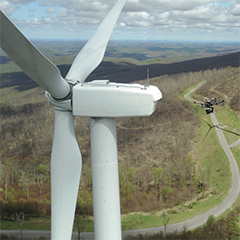It might not surprise the reader that wind turbines, blades, etc. need to be inspected intelligently to avoid faults turning into unnecessary problems, and to keep inspection costs at a minimum. But there is always news to tell when it comes to how to do it better. Asset inspections are in the ever-blowing winds of disruption – and the drone is in the air, documenting it all, affecting the future of the energy sector.
Is there a better way to inspect wind assets?
In the latest years, drones have taken over selected tasks from helicopters and human climbers, often in an approach that combines these methods. The drone can for example be used before an inspection done by helicopter or climbing, providing inspectors with the knowledge of which tools to bring.
Drone inspections identify blade defects faster than manned inspections, avoid hazardous man-hours, and improve asset productivity by catching problems before they become failures.
Figures of drones’ efficiency:
• 15-30 minutes – is drones’ demonstrated inspection time
• 75% or more – is how much drones reduce man-hours and turbine downtime for maintenance checks
• 15-20% – is the percentage that ground-based inspections typically miss of damages found by drones, risking higher failure rates and energy losses
• 6-8% efficiency loss and 500 percent increase in failure rate is what class 5 damage, such as a lightning strike at the blade tip, can lead to
• For class 3 damage, such as a trailing edge split, it is 3-6% efficiency loss and 200 percent increase in failure rate. Due to this, wind asset owners leveraging the power of drones see significantly improved finances.
Besides the many advantages, which we will dive deeper into in this article, drone inspections also come with a substantial challenge – they involve thousands of images. To identify the character and location of the asset faults, these images need to be reviewed before the inspection has any real value, and it is of critical importance to have a fast and intelligent system and workflow to do this. The article will explore how one experienced company approaches this.
This article provides an interview with Burton Putrah, VP, Data Engineering, at the aerial intelligence company, Measure. The interview was conducted by Measure’s collaborative partner, founders of the cloud software platform, Scopito.


























